This is the Mathematica file for the first worksheet:
https://vspace.vassar.edu/rakhakurel/Physics375/Rahul_Quantum_Wells.nb
And this is the file for a Finite Well:
https://vspace.vassar.edu/rakhakurel/Physics375/Rahul_Finite_well.nb
02/26/2010
Project Proposal:
https://vspace.vassar.edu/rakhakurel/Physics375/Project_Proposal_updated.docx
04/01/10
Homework on encryption:
https://vspace.vassar.edu/rakhakurel/Physics375/Rahul_Encryption.xls
04/06/2010
Homework on Wave Interference:
https://vspace.vassar.edu/rakhakurel/Physics375/Rahuls_WaveAnimation_-_Interference_class.nb
04/20/10
HW 7: Fourier Transforms
https://vspace.vassar.edu/rakhakurel/Physics375/Fourier.nb
04/22/10
HW 5: Diffraction Modeling
https://vspace.vassar.edu/rakhakurel/Physics375/Rahul_Diffraction.nb
PROJECT
Proposal:
My project will explore the phenomena of different types of scattering, especially Rayleigh scattering. Scattering can be either elastic or inelastic. Rayleigh scattering is an elastic type of scattering by particles that are much smaller than the wavelength of light. Mie scattering on the other hand involves particles that are much larger. For the project, I will model the intensity of the scattering as a function of different variables like wavelength, particle concentration, angle, etc. I intend to use Mathematica and Matlab for this modeling process. I am hopeful that the results will help research involving diffraction patterns of living organisms by giving us a more complete picture of what happens when light interacts with the organisms.
04/01/2010
The intensity of scattered light from a particle depends on the size of the particle, the distance from the particle to the observer, the wavelength of the scattered light and the refractive indices of the medium and the particle. Rayleigh made the assumption that the particle is very small and represented it as a point source. His model, therefore, is only valid when the size of the particle is much smaller than the wavelength of the incident light. The intensity of scattered light from a small sphere is given by (Zare et all):

where V is the volume, r is the distance from the particle to the observer , λ is the wavelength of the light, I0 is the intensity of the incident light and f is a dimensionless function of the refractive indices. Similarly, for N small spheres, the intensity of scattered light is given by (Zare et all):

Relative Scattering Intensity vs Wavelength:
![]() (This is approximately the size of a water molecule).
(This is approximately the size of a water molecule).
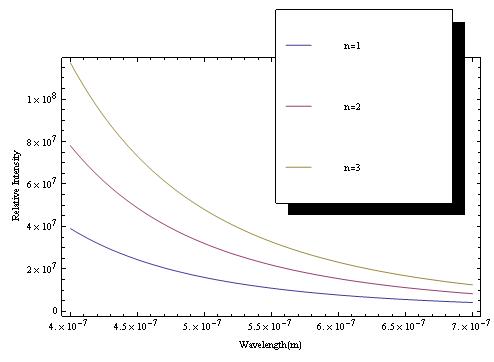
The dependence of Intensity on wavelength and the number of scattering particles can be seen above. Smaller wavelengths correlate to higher intensities. This graph partially explains why the sky is blue. Since blue light has a wavelength on the smaller end of the visible spectrum, the intensity of scattered blue light in the atmosphere is on the higher side. But by this logic, the sky should be Indigo or Violet. This is not the case because the scattering intensity as determined by Rayleigh’s model is not the only factor affecting our perception of the color of the sky. Our eye is more sensitive to colors towards the middle of the spectrum and intensity of solar radiation itself varies from wavelength to wavelength.
Polarization of Scattered light:
When unpolarized light is incident on a scattering sample, it induces dipoles in the particles. These dipoles oscillate in any direction perpendicular to the beam of incident light and the intensity of the scattered light is the superposition of the intensities due to many dipoles oriented at different directions perpendicular to the incident beam. The amplitude of the scattered light at any point around a dipole should be proportional to the projection of the dipole moment on a plane perpendicular to the viewing axis. As a result, the light scattered in the forward direction is completely unpolarized and is completely linearly polarized in the directions perpendicular to the incident beam.
The angular dependence of the intensity of the scattered light is represented by the following relationship (Zare et all):
![]()
where θ is the angle between the incident beam and the line of sight of the scattered beam and k is a constant.
The following graphs illustrate this relationship:
![]()
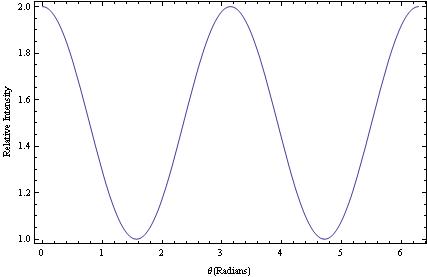
Note that the intensities at 0 degrees and 180 degrees are twice the size of the intensities at 90 degrees and 270 degrees.
This information can be represented using Polar Plots which provides a better visual guide to how light is scattered. Note that for all polar plots on this page, the particle is located at the origin. The direction of incident light is along the y-axis, from negative y to the origin. The angle of scattering, θ, is measured counterclockwise from the positive x-axis.

Rayleigh-Debye Theory:
When the scattering particles are not very small compared to the wavelength of the light, Rayleigh’s model is not accurate. When the scattering particles are large, the interference effects of multiple scattering centers results in a more complex angular dependence for the intensity. The Rayleigh-Debye theory is a modification of the Rayleigh Theory that introduces a dimensionless form factor P(θ) into the Rayleigh equation such that (Zare et all):
![]()
Where, IRD is the intensity predicted by the Rayleigh-Debye Theory, IR is the intensity predicted by the Rayleigh Theory and the form factor ![]()
Where, ![]() and
and ![]()
a is the radius of the sphere and n is the refractive index of the medium.
For low angles (θ ->0) and for small spheres (V->0), the function P(θ) goes to unity such that IRD = IR
The dependence of P(θ) on θ can be seen in the following plots:
![]()
The refractive index is for water. The radius is larger than the wavelength of the light (yellow).
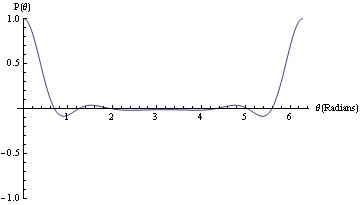

For the same values and given I0 = 1, the plots showing the angular dependence of Intensity are very similar to the plots for P(θ):
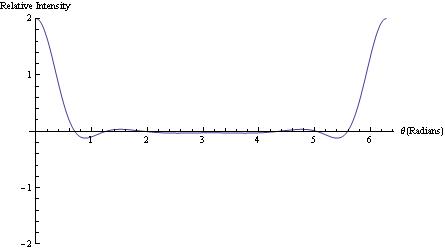
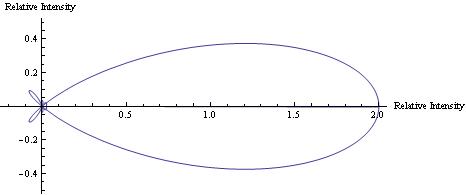
The following animation shows how the nature of scattering changes as the radius of the particle changes from 2 nm to 902 nm.

The animation shows that for smaller particles, the intensity of the light scattered parallel to the incident beam is twice the intensity of the light scattered in the perpendicular directions. For larger particles, the intensities in the forward directions (0 degrees to 90 degrees and 270 degrees to 360 degrees) are much greater than in the reverse directions. Since the size of the plot is shrinking with increasing particle radius, we know that the overall intensity of the scattered light decreases with increasing radius.
Issues with Mathematica/ Plots :
The major concern with regards to the plots generated was that the relative intensity for certain angles was less than zero. Despite checking all my equations and calculations, I could not determine how this happened. The polar plots for larger particles have dumbbell shaped features around the origin. It looked as if for large particle radii the intensities scattered in the reverse directions (between 90 degrees to 270 degrees) are very small except in the two diagonal directions (the part that looks like the tail of a fish). I planned to further study what determines these angles which get higher intensities in the reverse direction. But I realized that these dumbell shapes started emerging as soon as the relative intensities took negative values. The problem with these dumbells is there isn’t a one to one correspondence between angles and intensities. So we need to interpret these plots with some caution.
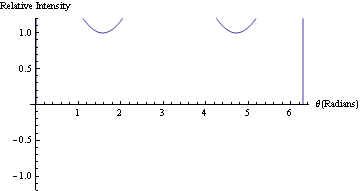
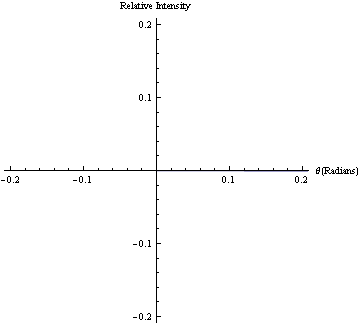
The Mathematica codes and outputs for all the graphs and simulations on this page can be downloaded by clicking on this link:
https://vspace.vassar.edu/rakhakurel/Physics375/Project.nb
Applications:
I started out with the goal of facilitating research involving different micro-organisms, but the project ended up being more of a guide towards understanding Rayleigh and Debye scattering. That being said, I feel that the information can be used in experiments involving organisms like Tetrahymena thermophila. For instance, it is worth verifying if the scattering intensities are dependent on the density of the organisms. If so, observing scattering intensities could help us determine the densities of the organisms.
References:
R.N.Zare, B.H.Spencer, D.S.Springer, M.P.Jacobson,Laser: Experiments for Beginners, (University Science Books, California, 1995).
Links:
Resources on Mie Scattering:
http://www.philiplaven.com/ (contains articles, simulations, etc)
http://omlc.ogi.edu/calc/mie_calc.html (Mie calculator for various parameters)


Hi Rahul, I’m with kyle on this. you’ve explained thing in great detail and your graphs illustrate a lot about the relationships you set out to model in the beginning. However, i would have liked to know more about the practicality of these results than merely why the sky is blue. (Although I’m glad someone finally explained that to me) Perhaps industrial or scientific applications.
Rahul,
Looks really good. Couple of small points: So what? You’ve explained to us how Rayleigh scattering works, but you haven’t explained at all what we can do with this knowledge. What types of experiments can be done with these results? Second did you use Matlab? If not, I would remove mentioning it from the abstract at the top. Great otherwise.